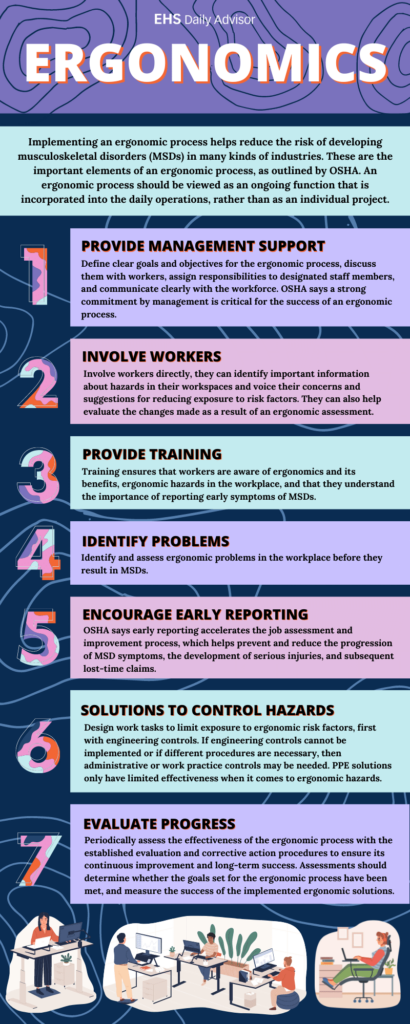Keep workers healthy with ergonomics on the job
- Ergonomics: fitting the job to the worker – not the worker to the job.
- Why ergonomics, especially those for WFH employees, is crucial to reducing musculoskeletal injuries and fatigue.
- Learn ergonomic best practices, whether standing, sitting, reaching or lifting.
- How taking frequent micro breaks to stretch the back, neck, shoulders and wrists can ease muscle tension, improve blood flow/circulation and reduce fatigue.
When we hear the term ergonomics on the job, we often think of office environments…or more recently, WFH environments. Actually, ergonomics is applicable in any job position or work assignment. It’s the science of fitting the job to the worker (not the worker to the job) in order to reduce stress on joints and ligaments to eliminate muscle strain and fatigue. A variety of factors can contribute to musculoskeletal injuries and fatigue, including:
- The amount of force, or pressure, required to complete a task
- Awkward postures/positioning
- Static postures or holding the same position for more than 20 seconds
- Repetitive activities
- Continuous contact of body tissue on a surface
A focus on ergonomics on the job is a great way to prevent injuries and keep workers’ benefit claims low. Here are a few basics to help your enterprise get started on implementing ergonomics best practices in your workforce.
General ergonomics on the job practices
Employees should focus on maintaining neutral postures, which include:
- Standing and sitting up straight to maintain the “S” curve of the spine
- Keeping neck aligned and wrists in neutral positions
- Avoiding awkward postures
- Elevating equipment or working surfaces to a comfortable height using risers, blocks, or other stable objects to avoid awkward or prolonged bending of the back, neck and shoulders
- Using step stools, ladders or long-handled tools to avoid excessive reaching overhead
- Avoiding squatting for prolonged periods of time
- Avoiding twisting movements when moving loads by moving feet, turning the whole body instead
Tasks should allow for periodic movement and stretching:
- Employees should take micro breaks to stretch their back, neck, shoulders, and wrists to ease muscle tension, improve blood flow/circulation, and reduce fatigue.
- Instruct employees to shift their weight from side-to-side or rest a foot on a footrest or stable object when they find themselves standing in the same location for extended periods. Employees required to stand in the same position to complete their work should be instructed to wear comfortable shoes and be provided with anti-fatigue mats.
- Encourage employees to take a short walks (1-2 minutes) at least once every 40 – 60 minutes. Suggest that they take the long route to their destination to help get in a few more steps. Also motivate them to take walks on their breaks, if applicable.
- Urge employees to rotate tasks to reduce the risk of repetitive motion injuries. Create a system where they spend only a certain amount of time on a repetitive task before switching to another. Tell them to desist if they notice any discomfort or strain and perform a different task for a while instead.
Use cushioning whenever possible:
- Select tools with rounded edges and larger and/or cushioned handles to allow use of a power grip, not a pinch grip.
- Wear shoes with cushioning and good support.
- Use anti-fatigue mats with beveled edges when standing for prolonged periods.
Ergonomics for office workstations
Attention to detail counts when setting up an office workstation to optimize efficiency and comfort, both with regards to the equipment being used and the individual in question. Here are a few tips for setting up office workstations as you keep in mind ergonomics on the job.
CHAIR – Adjust the:
- Height of the seat so thighs are parallel to ground and feet rest comfortably on the floor or on a footrest.
- Height of the backrest (if possible) so the lumbar support is level with the curve of your low back.
- Backrest tilt so it’s tilted backwards slightly (approximately 10 degrees).
- Seat pan (if possible) moving it forward or backwards so there’s a one-to-two-inch gap between the front edge of the seat cushion and knees.
- Armrests (if possible) so elbows are bent 90 degrees and arms are supported a comfortable distance from the body.
Make your chair work for you
- Lean back against the chair so it supports the upper body.
- Consider using a footrest to help lean backwards against the chair’s backrest to ease leg problems and lessen low back issues.
COMPUTER MONITOR(S) – Adjust the monitor(s):
- Placement – so the monitor(s):
- Is directly in front of employee
- At a comfortable viewing distance (about an arm’s length away or 18 – 30 inches)
- At a 90-degree angle from windows to reduce glare
- Height – so the top of the screen is at or just below eye level. If employees use bifocals or trifocals, the monitor may need to be raised slightly higher.
- If using dual/triple monitors, keep them similar in size, as close as possible to each other and centered in front of employee.
KEYBOARD & MOUSE
- Position the keyboard/mouse at the same height and at a distance, allowing elbows to remain close to the body.
- Use a keyboard tray if possible.
- Relieve contact stress on wrists by using padded wrist cushions positioned in front of keyboard and mouse.
Non-sitting roles
For employees who perform numerous manual tasks, consider the following tips to reduce the risk of a repetitive strain injury (RSI):
Employees using carts should:
- Have carts with handles and large wheels that are high enough so the employee’s feet won’t hit the bottom of the cart as they walk.
- Conduct a pre-use inspection by looking for loose or worn out wheels, stability issues, ease of movement and maneuverability.
- Never use damaged carts or those which obstruct the employee’s view.
- Push the cart, standing at one end, not on the side, rather than pulling it.
- Pull carts only when exiting elevators or passing through swinging doors.
- Walk at a normal or slow pace.
- Keep the cart close to the body.
- Get help when moving large or fully loaded carts.
Posture Pointers – When lifting, carrying, and shelving items, employees should:
- Bend at the knees and keep back straight.
- Hold loads close to body and lift with legs.
- Kneel with a knee cushioned on the floor or sit on a low stool when shelving on lower shelves.
- Use a foot stool to safely reach upper shelves.
- Avoid overstretching which puts stress on shoulders, arms and upper back.
Grip Matters – When shelving items, employees should:
- Use a “whole hand grip” where the object is seated firmly in the palm of the hand, as opposed to a “pinch grip” where the weight of the item is carried through pinching the fingertips. A pinch grip uses only 25 percent of a hand’s strength versus a whole hand grip.
- Use a two-handed power lift when shelving heavy items to disperse the load and maintain neutral hand positions.
Work Organization – Plan for success by:
- Varying tasks whenever possible.
- Working at a comfortable pace – a fast pace doesn’t allow the body to recover from repetitive motions.
- Alternating arms when possible to lessen the strain on the dominant arm, hand and wrist.
- Taking frequent micro breaks and stretching as needed.
A few more ergo tips for “work-from-homers”
- Don’t hunch forward. When sitting in your chair, make sure your posture is comfortable but close enough to reach your desk.
- Make sure to keep your feet flat. You’ll restrict blood flow to your feet if they aren’t resting comfortably on the floor.
- Avoid working in bed. Working with your laptop propped up on your legs can cause you to hunch over, putting extra strain on your back.
Share this infographic from EHS Daily Advisor with your insureds

Agents, take a look at our Workers’ Compensation Program to add to your portfolio of insurance solutions.
This blogpost originally appeared on our Tribal blog. It has been slightly modified and updated to better reflect the needs of our commercial producers and their customers.

